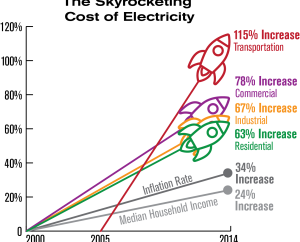From the ancient days, we have been studying electrical phenomena until the seventeenth and eighteenth centuries in the progress of theoretical understanding. In the ancient days, electricity was considered to be different from the magnetism. Various types of phenomena like electric discharges, static electricity, lighting, and electric heating are known to be relevant to electricity. Through the development of Maxwell’s equations, only the relativity of electricity and magnetism are defined as the same. And that was nothing but the electric phenomenon. Nowadays we focus on the Energy Rates which would make a difference following the consumption. The set of physical phenomena is known to be electricity following the motion and presence of matter. The electric charge might be either positive or negative which produces the electric field. The most dramatic effect of electricity is lighting. A magnetic field is produced through the movement of electric current.

Background of electricity:
The people were aware of the shock of electric fish before they come to know about electricity. The electric fish is considered as the thunderer of the Nile from 2750 BCE of the ancient Egyptian texts. The electric fish in the Nile is considered to be the protector of all other fish. Afterward, ancient Greek, Arabian, Roman naturalist and physician have mentioned about the electric fish in their view. Some of the ancient writers also mentioned about the electric shocks about the electric fish. And then the shocks of the electric fish are the best medicine for those affected by gout or headache. The person who was affected by gout or headache is suggested to touch the electric catfish. The people who belong to ancient culture surrounded by the Mediterranean Sea have a clear view that the rod of Ambar attracts the lighting when it is rubbed with the cat’s fur. Around 600 BCE, Thales of Miletus deals with the observation of the static electricity. Thales of Miletus is illogical about believing the attraction of the magnetic effect but the link between magnetism and electricity was proved by science in the later years. In the 18th century, Benjamin Franklin conducted extensive research over electricity which is documented by Joseph priestly in the year 1767. Joseph priestly has carried out the extension of history and the theory of electricity. Then he has given the present status of electricity in his extensions. Until 1600, electricity would remain an intellectual curiosity than a millennium. William Gilbert, the English scientist wrote about the study of electricity and magnetism in his work. The new Latin word electricus was coined by William Gilbert which refers to the object that attracts the small objects after it was rubbed. The new Latin word leads to the rise in the English word known as ‘electric’ and ‘electricity’ which was first appeared in the work of Thomas Browne in the year 1646.
Conceptual electrical problems:
The substitution of the word charge is making more problems with electricity. The old scientists discussing the quantities of electricity and the flow of electricity which respectively known as charge and current. The old scientists determine that the readers of the old existing scientific papers will understand that the term electricity is nothing but it means charge.
